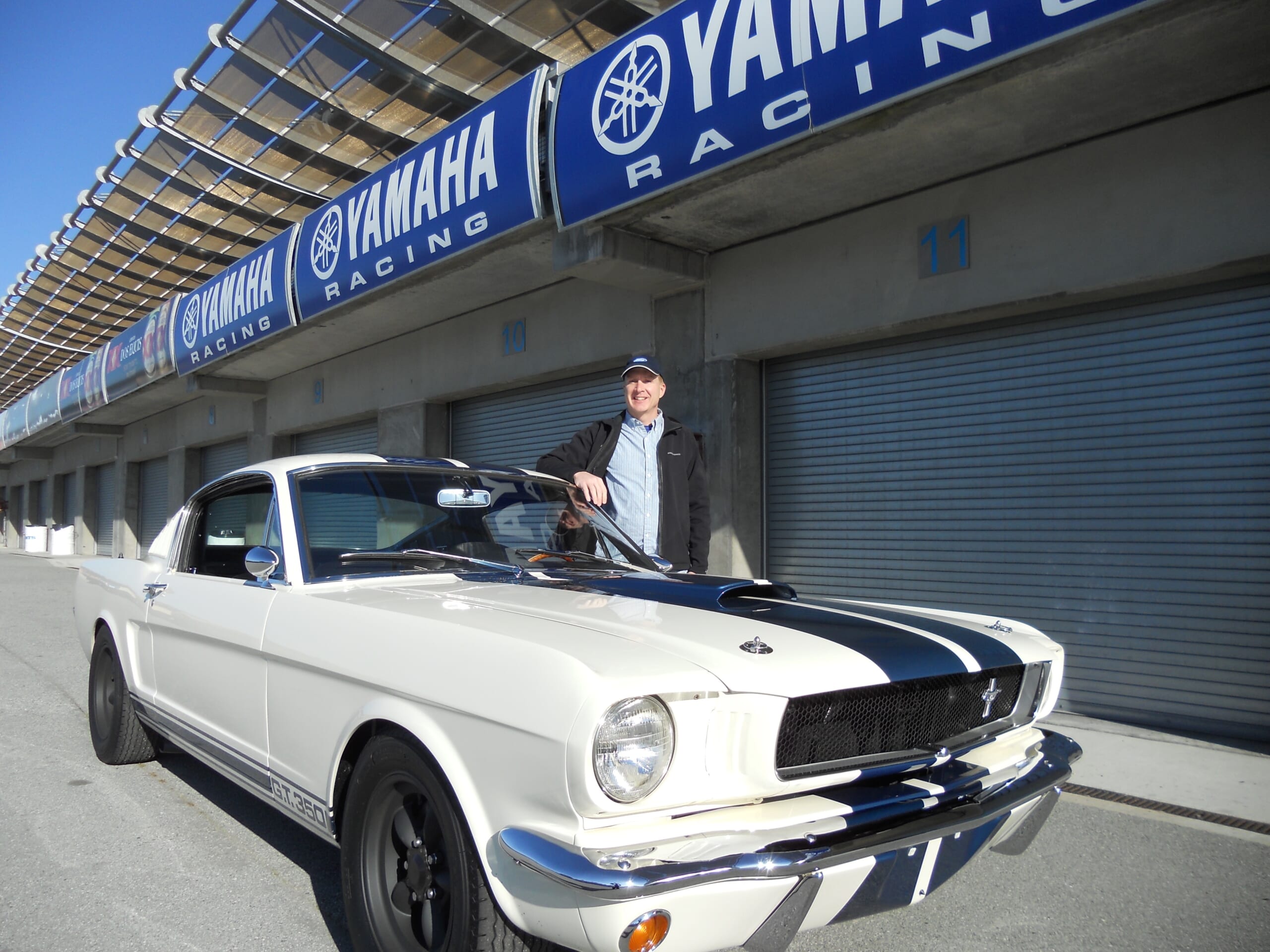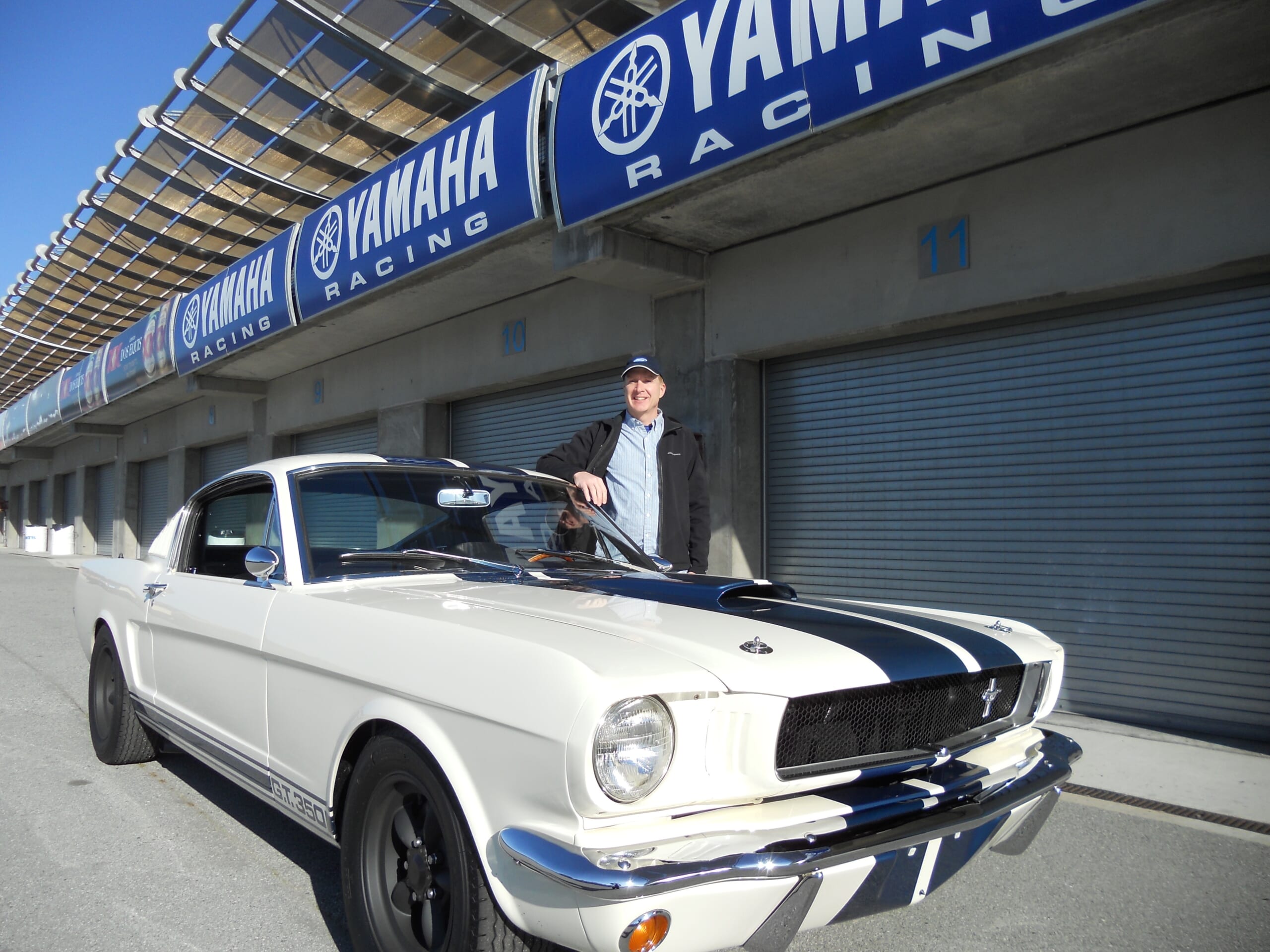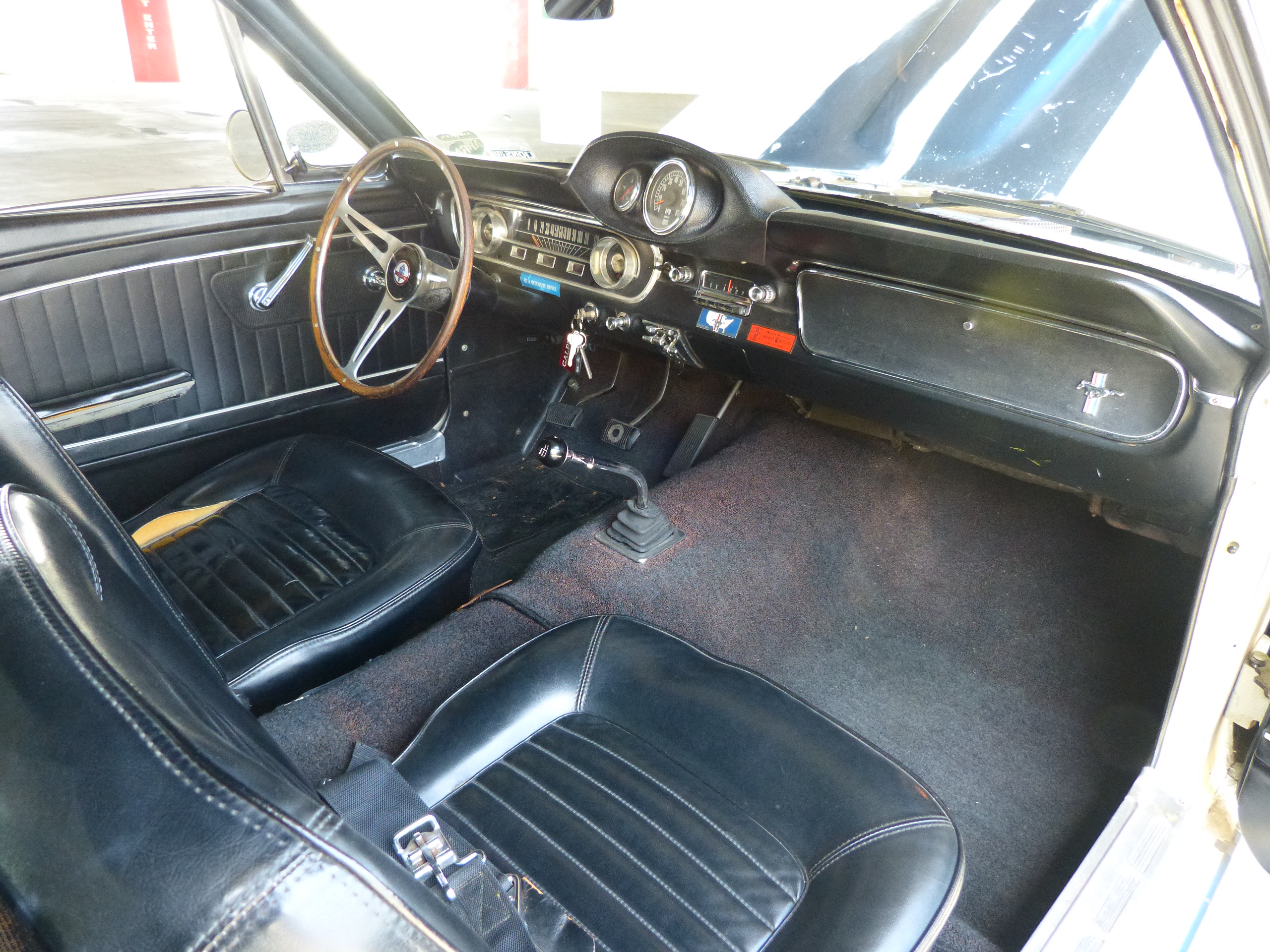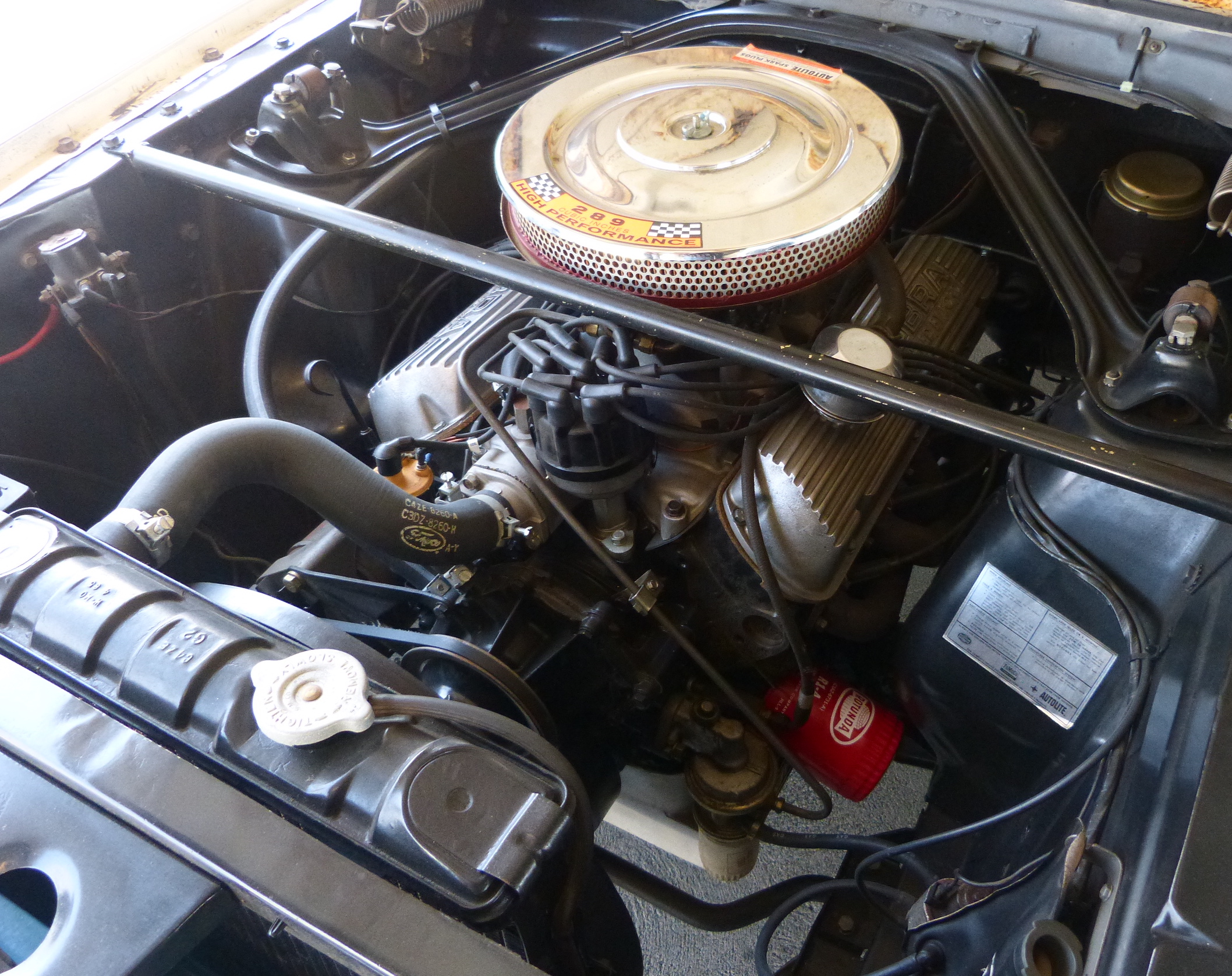What It Feels Like to Drive a 1965 Ford Shelby GT350
Testing the race track mettle of an all-time classic.

Roaring down the front straight at California’s Mazda Raceway Laguna Seca in a glossy white-with-blue stripes 1965 Shelby GT350 straight out of my youthful fantasies, I concluded that I could safely tick another item off my bucket list. “Drive a race-prepped GT350 on the track?” Check!
Sure, these classic cars raced before I was born, but they cast a legendary shadow over the ensuing decades with their seeming perfection of execution. What car guy wouldn’t thrill to the sound of the Shelby’s beastly V-8 echoing off the concrete pit wall? Or to the sight of the distinctively jagged Mustang hoodline through the windshield, split by Shelby’s signature blue stripes?

Invited by Ford to drive its latest hot-rod Mustang, I lamented the inability to compare it with the greatest hot rod Mustang, the original Shelby GT350 of 1965. Ford executive vice president Jim Farley raised his eyebrows at my thought. “Well,” he started slowly, “I have my GT350 here at the track, and you could drive that one.”
Gleeful at the prospect of wheeling one of the all-time great cars around one of the all-time great tracks, I headed to the pit lane before he could change his mind. Farley had the Shelby brought from its storage spot and it crouched by the row of garages, already warmed up.
Carroll Shelby built his GT350 from the first-generation Mustang at Ford’s request to help the new car cultivate a performance image. It is easy to forget how delicate and small those cars were, compared to the hulking beasts of today.
The door opens with an unremarkable click. Though this is a vintage racer, there is none of that Dukes of Hazzard-style, though-the-window nonsense. Just open the door ands slide into the low, flat seat. The original skinny Ford lap belts have been replaced by modern, thicker restraints, but that is the sole nod to upgraded safety here.
The old car’s airy cabin is lighter and more open than that of its modern counterparts. Indeed, it’s a reminder of why the cockpit was sometimes referred to as the car’s “greenhouse” back in the old days.
I hit the starter and the Shelby’s small block 289 (that’s 4.7 liters by today’s standards) instantly barks out the soundtrack that has stirred passion for these cars for a half century. The volume level seems just right; loud enough to enjoy without achieving the permanent hearing loss-levels of a NASCAR stock car.
Shelby’s engineers rated the 289 at 306 horsepower in 1965, but in the best vintage racer tradition, Farley’s had his car’s engine upgraded. He estimates it is good for 350 horsepower, so it should be plenty of fun on the track.
I grip the thin wooden rim of the original equipment Shelby steering wheel and put some effort into pointing the car toward the pit exit. No power steering for cars with racing or sporting intent in those days, and the steering wheel’s large diameter is intended to provide some leverage. The wood rim is warm to the touch, reminding me of my lack of gloves. Driving this car for many laps would surely blister my hands.
The ancient warrior burbles past the shiny new Mustangs lining the pit lane, awaiting their abuse at the hands of my colleagues lapping around the circuit. At the pit exit to the track, the marshal gives me the thumbs-up to head out, seeming especially enthused by the sight of this classic GT350 joining its modern successors.
Accelerating onto the track, the Shelby’s gas pedal is finally on the floor and the exhaust pipes are announcing our arrival to the showroom-quiet Mustangs already circulating. Shifting from second gear to third is a long throw on the old-style shifter with its enormous lever where today’s cars have tiny joystick shifters.

It connects to a four-speed manual transmission whose gears are spaced a bit too far apart to keep the engine in the meat of its power band on upshifts. Revs fall further on gear changes than with newer six-speed transmissions.
None of this is surprising, as the evolution of shifters and transmissions to shorter throws and closer ratios has been very visible. However, what is surprising is the lack of power from the old Shelby’s V-8.
Sure, the old car’s obsolete brakes, skinnier tires and old-fashioned recirculating ball steering were going to be no match for the new Mustang’s hardware. But I’d expected that the old carbureted, unmuffled small block race motor would hold its own against the new car’s emissions-certified engine.

Wrong. Hammering the ’65 for all its worth (sorry, Jim!), there is no way to keep the newer cars from pulling briskly away on the straights, leaving me to enjoy the car’s roar, but feeling like there’s more bark than bite here. Sigh.
When the turns approach, things get worse, as anticipated. The brakes lack the bite of the latest stoppers and the tires aren’t as grippy as the near-race specification rubber that comes on the hottest new models.
The shock absorbers are old-fashioned and the springs are soft, another bad combination for the track. The GT350’s nose dives under braking like it is going to scrape the yellow dotted line off the pavement.
At turn-in for the curve, the I spin Shelby’s giant wheel like a ship’s helm, but the car doesn’t change direction, at least, not at first. Instead, it heels over like a sailboat changing tack.
But once the soggy springs are compressed and the squirmy tires have found grip, the car does begin to turn. Frequently, this occurs too late for me to get the car onto the course I intended through the turn, so I’m reduced to touring the curve with an eye on where I want to be next time around.
After a few laps, I’ve learned to anticipate the lag by braking and turning early, and the GT350 follows some semblance of the ideal racing line. But the car isn’t enjoying the drive, and I feel bad about making it do something it doesn’t really want to do. Least of all, while being humiliatingly shown up by its faster successors, which keep racing past.
No worries, as all older siblings know, the kids might be younger and faster, but they’ll never be as cool.
The ’65 GT350 needs to retire to weekend cruises of scenic roads, café runs and exhibition laps at the track where the driver can mat the throttle and fans can appreciate the peerless sight and sound of a classic Shelby running hard.
It was a thrill for me to be able to enjoy that same experience from inside the car, and I could see the track workers appreciated the car’s beauty as I rumbled by.
But this fabulous vintage machine needs to just be appreciated for its sights, sounds and rich racing heritage. Just put away the stopwatch and enjoy it.
For the latest car news, follow @MaximRides and Dan Carney on Twitter.
